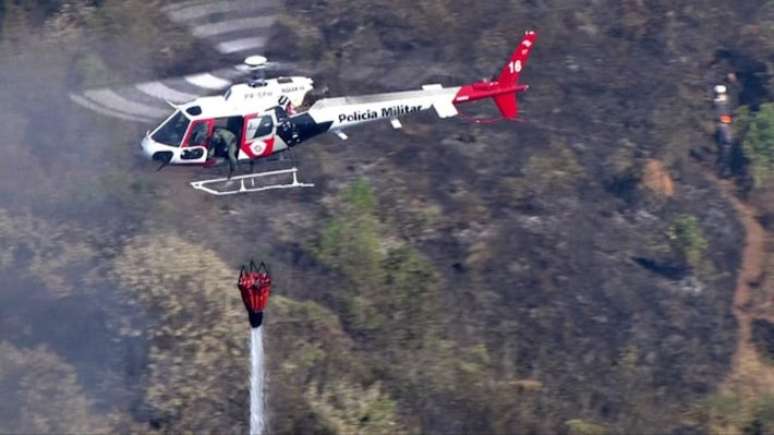Fires within the state worsen the situation, increasing consumption in the fight against the flames
Drought and heat are already causing municipalities to adopt or plan water rationing in the interior of São Paulo. Important cities such as Bauru AND St. Joseph of Rio Preto address the shortage of water supply. In Bauru and other cities, rotation is already in place. The fires make the situation worse, increasing the consumption of water, used to clean soot in homes and fight the flames.
According to the State Civil Protection, at least 53 municipalities in the state are in emergency conditions due to drought and fires. At the end of July, there were ten cities in these conditions.
With the rainy season expected to be delayed this year, municipalities are running campaigns and imposing fines on those who waste water.
On Wednesday 11, the municipality of Atibaia declared a state of water emergency and adopted rotation due to the risk of shortages. The city was divided into three sectors that receive water on alternate days.
The municipal decree allows fines to be imposed on those who wash cars, sidewalks or water gardens. Residents have been urged to report waste. “The measure aims to mitigate the effects of drought in order to maintain the water supply system with the least possible damage to the population,” the decree reads.
The Water Department of Bauru, a city of 380,000 inhabitants, began a series of maneuvers on the network on Monday 9th to adapt to the drastic drop in the level of the basin that collects water from the Batalha River. This Wednesday, the river level reached 1 meter, more than three times below the ideal level, which is 3.20 m. Several neighborhoods began receiving water from deep wells to balance the distribution of the liquid. Rationing began on May 9th and currently the neighborhoods have water for 24 hours and 48 hours without.
In Vinhedo, rotation has also been underway since May, and the municipality has begun using water from private artesian wells. The fine for wasting water is R$663, which doubles in the event of a repeat offense. Residents complain that they receive dirty water when the supply resumes during rotation. Sanebavi, the municipality’s sanitation company, said that the water returns very quickly and washes away waste trapped in the pipes.
Wash the soot
According to the Basic Hygiene Company of the State of São Paulo (Sabesp), the increased use of water to clean soot from fires also harms the supply. At the end of August, the company even issued a warning about the risk of water shortages in the cities of Franca and Restinga due to the high use of water to clean soot.
In Sorocaba, Mayor Rodrigo Manga (Republican) signed a decree declaring a climate emergency in the municipality. The law provides for a fine of up to R$ 150,000 for anyone caught setting fire to the bush. Due to the large number of fires, the use of water to refuel the Fire Department and Civil Protection tankers to fight the fires has put the urban water supply at risk.
The fires that spread inside, in addition to increasing water consumption to clean the soot and fight the flames, also have a direct impact on the water supply. In Marília, on Sunday 8, the fire affected transformers and equipment of the Rio do Peixe collection network, which supplies 50% of the city. The suspicion is that a fire that broke out on neighboring land affected the station. There was an occasional shortage of water until Thursday morning.
Cantareira at attention
The Cantareira System, which supplies much of the Metropolitan Region of São Paulo, covers 55% of the total useful volume and operates in the warning range, according to the National Center for Monitoring and Warning of Natural Disasters (Cemaden). The warning range begins when the system operates below 40%.
With the lack of rain, the reservoirs lost their water reserves. At the end of August, the total usable volume was 57%, while at the end of July it was 62%. At the beginning of September 2023, Cantareira was operating with 73% of its usable volume.
Since May of this year, the Cantareira System has been supplied with water from the Paraíba do Sul River basin, collected in the Jaguari Reservoir. Currently, 7.5 cubic meters per second are captured. According to Cemaden, the system is currently classified as experiencing moderate to severe hydrological drought.
In addition to Cantareira, RMSP has six other supply systems, but some are in a more critical situation. Rio Claro obtained 26.9% of the useful volume this Thursday, while the Guarapiranga reservoir 40%. On average, the total volume stored by the facilities was 52.8%, but with negative operation, that is, more water outgoing than incoming.
The scenario also affects river basins that are important for public supply. This Thursday, the Piracicaba River, which feeds Piracicaba and Americana, had a flow rate 60% lower than the September average, according to the Piracicaba, Capivari and Jundiaí River Basin Consortium (PCJ). In the urban area of Piracicaba, the situation is more critical, with a flow rate of just 18.3 thousand liters per second, a third of the historical average of 55.3 thousand liters.
The Municipal Water and Sewerage Service (Semae) captures 300 to 400 liters per second, but the poor quality of the water causes a drop in oxygenation and makes treatment difficult. This happens, according to the city hall, because some municipalities upstream from Piracicaba do not treat wastewater. The low level has caused fish to die. The waterfall, a tourist attraction in the city, has turned into streams of water between rocks.
In Porto Ferreira, the Mogi Guaçu River, at the capture point, is 0.73 meters, when the minimum required for capture is 0.50 m. “Given the scenario of attention due to the level of the water source and, above all, with the high temperatures that have generated an increase in water consumption, the concessionaire emphasizes that the rational use of the resource by the population is an important ally to overcome the most critical moment of this year’s drought”, said the concessionaire BKR, responsible for the supply.
No rationing
Sabesp reported that the Integrated Metropolitan System operates this Thursday with 52.8% of the total volume and remains at the average of the last five years, or 52%. “The system is composed of 7 water sources, which makes it possible to supply different areas of the metropolis with more than one system, depending on the needs,” he explained.
The company highlighted the investments made since the 2014/15 water crisis to make the system more robust. “There is no rationing at the moment in the 375 municipalities managed by Sabesp, but, as demonstrated by the severe drought and high temperatures affecting the entire country, the Company stresses that the conscious use of water is essential at all times,” it said in a statement.
Rain may delay
According to Cemaden, weather forecasts indicate a probable delay in the start of the next rainy season, which will result in an extension of the drought period in rivers in all regions of the country, except the southern region.
The probable delay is due to the increased warming of the Atlantic Ocean in the Central American region, which favors heavier than normal rainfall in this region, which causes a reduction in precipitation over much of South America, including Brazil. As a result, the drought situation is expected to persist or even worsen in most of the country’s river basins.
Also according to Cemaden, the causes of the drought in the Southeast region, which includes São Paulo, are a combination of factors such as the deficit in rainfall last season due to a more intense action of the El Niño phenomenon. As a result, there was no recharge of the aquifers, keeping the rivers below the expected levels.
There was also an early dry season in the state, with little rain since May. This left the soil and vegetation extremely dry, creating an environment favorable to the spread of large fires.
The body linked to the Ministry of Science, Technology and Innovation highlights situations that act in the long term, such as climate change, which generates a progressive warming of the atmosphere, producing longer sequences of days without rain, and changes in land use, with the replacement of forest areas with fields dedicated to agriculture and livestock farming, which translates into a reduction in environmental humidity and, consequently, precipitation.
Source: Terra
Rose James is a Gossipify movie and series reviewer known for her in-depth analysis and unique perspective on the latest releases. With a background in film studies, she provides engaging and informative reviews, and keeps readers up to date with industry trends and emerging talents.








